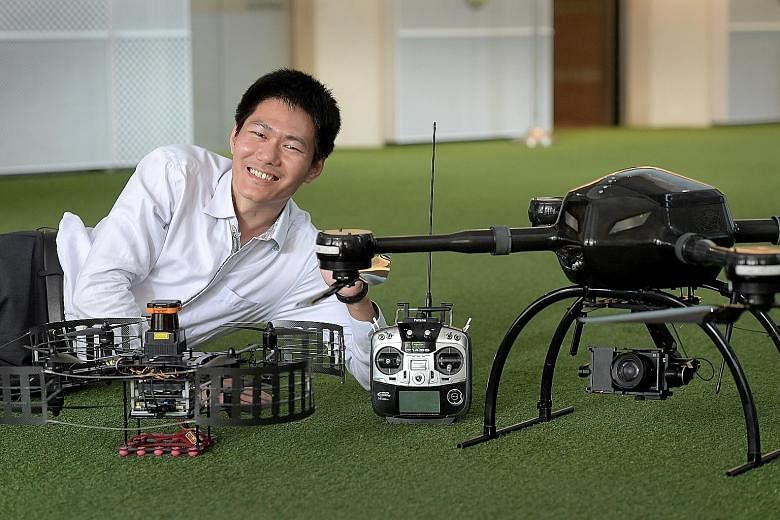Dr Wang Fei, who was born in China's Jiangsu province, became immersed in the world of unmanned aerial vehicles (UAVs) while studying at the National University of Singapore (NUS). He said he named his company after the two lions in his life - the lion in the NUS emblem and the lion in Singapore's national coat of arms.
Q What are UAVs?
A The difference between UAVs and normal flying vehicles is that UAVs have no pilots. Many UAVs for consumers are manually controlled by wireless signals, with every movement controlled by the human.
Q: What are some of your products and how are they different from what's on the market?
A For our company, we produce products that are more autonomous, so the user gives only very high-level commands, such as taking off and landing, and flying to specific points using GPS (Global Positioning System) coordinates. The UAVs will do path planning on their own, so there is no need to continuously control them.
The BlackLion-168 is an outdoor product that flies in open space. When you do automatic control of vehicles in the air, you need the GPS location. The use of GPS technology is mature, so the outdoor product we have now is functionally quite common compared with other products.
We focus more on industrial standards, such as achieving one- hour flight time, which is longer than (the flight time of) most UAVs on the market, which is about 15 to 30 minutes.
Singapore is very urbanised, with not many open-space land areas. Therein lies the problem of using these flying machines in places where there is no reliable GPS signal, such as indoors, in tunnels and under bridges.
So we came up with our other product, the BlackLion-068, which can be used where there is no GPS signal.
It has two configurations, one with a Lidar sensor, which uses lasers, and another with a depth camera. We created an algorithm that can use either to determine the UAV's position with better accuracy than using a GPS signal, and to be able to create a structural map of its surroundings.
With this structural map generated, the UAV can autonomously plan its flight path to avoid obstacles. Other existing GPS-less navigation technologies usually require a lot of pre-set-up equipment and are not applicable to unknown or inaccessible environments.
Q How are these UAVs being used?
A Cameras are most commonly attached to the UAVs, but it is also possible to load them with industrial sensors to observe the shape of the land, infrared cameras to detect temperature differences, and even air pollution sensors.
We have been doing projects with the Singapore Land Authority (SLA). There are many buildings that need to be maintained in Singapore and the SLA wants to know the conditions of the land and those buildings.
While it typically sends people to walk around the land and buildings, people may not be able to observe the rooftop or the facade in great detail, so UAVs can help them with the monitoring work.
We have also worked with local logistics companies to do automated stock checking, as there is no GPS signal inside the warehouses.
Also, Singapore has a lot of tunnel systems, such as for sewage, all of which need to be inspected regularly. However, there is no way to efficiently inspect and maintain them, so UAVs can be a good choice.
We kicked off a project with (national water agency) PUB this year to work on a project for sewerage tunnel inspection.
Q How long did it take to develop the products?
A It took six months to develop our first product, the BlackLion-168, which we completed in June last year. The BlackLion-068 came six months after that.
Q How did you get the funding to start the company and what does the revenue look like?
A We initially self-funded, with $500,000 in total coming from 15 people. Our revenue mostly comes from selling the products overseas, such as in China, where they use the UAVs to inspect power lines. Another source of income comes from providing services such as data collection.
We started the business at the end of 2014 and sold our first products in China in June last year. We have broken even and expanded the team from four to 11 people. Our revenue in the year to date is about $1.5 million.
Q What kind of help did you get from the Info-communications Media Development Authority of Singapore (IMDA)?
A Since incorporation, we have been working with the IMDA. As our background is in research and development, the authority helps us with the business side of things, such as giving us suggestions on the business model, finance and operational procedures.
It has also helped to comprehensively evaluate our products and assisted us with certification. The certification helps because when government agencies are interested in using our products, it can increase our credibility.
Q How do you plan to move forward with the company and its products?
A We have already achieved the ability for the UAVs to fly autonomously in a short tunnel. Along the way, we need to do engineering for them to work in the real environment of deep tunnels, where it is totally dark.
We need to illuminate the tunnel, but the illumination has to be compatible with the sensor. We also have to prolong the flight time without increasing the size of the UAVs, as they usually fly in cluttered space.
We expect to solve these problems in about 11/2 years to be able to push out a product that is mature enough to deal with actual working conditions and not just for demonstrations.


